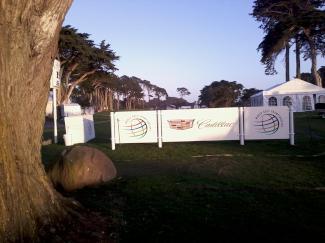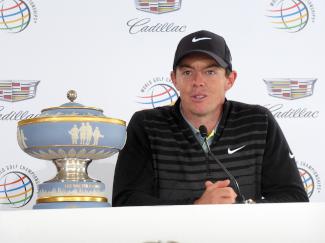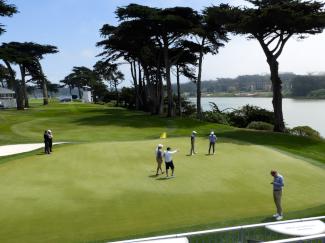Featured Golf News
A First-Timer's Observations of the WGC Cadillac Match Play Championship
The WGC-Cadillac Match Play is being held at San Francisco's TPC Harding Park this year, well within striking distance for me, a resident of the city. I've played Harding a couple times, as well as Fleming, the nine-hole course there, so I'm fairly familiar with the setup.

Even so, reporting on a PGA tour event was a new experience. And as a consequence, puzzling out how to cover a "match play" tournament was a bit of a head-scratcher. But I was up for the challenge, given that the tournament was showcasing the top 64 players in the world, minus Tiger and Phil and Luke Donald.
Just getting to Harding Park is tricky, though not impossibly so. For some reason, The Great Highway that runs along the Pacific Ocean was blocked off. It seemed Harding was expecting 100,000 spectators, which by my later finger count was overly optimistic, by about 99,000. But after following some back roads, I found the media parking, appropriately enough at the SF Zoo. Once I showed my media bona fides, doors began to open. (Though first they had to "wand me" to make sure I wasn't packing heat.)
The shuttle bus dropped me at Harding Park about 10 minutes later and was within shouting distance of the media center. There they welcomed me and patiently gave me my photo ID, answered my na´ve questions, and offered lunch. I grabbed a bottle of water, picked up a spectator guide, a map of the course, descriptions of the holes, and a list of the daily pairings. I was excited to dash on out there and catch some of the action.
One key question - and I had been asking myself this for a couple of weeks - was: Should I follow one good match from hole to hole to hole? Or should I try to see a lot of players but only bits of their matches? You can't do both (at least not simultaneously). I could have stayed in the media center and watched the telecast on a huge television screen, which apparently some old pros do, but I was there to witness the tournament live.

Jordan Spieth at the Range
I made a beeline to the first hole to find French phenom Victor Dubuisson, who barely lost to Jason Day in last year's Match Play finals, despite his otherworldly scrambling. This year he was playing his first-round match against South African Charles Schwartzel. Sadly, the misnamed Victor immediately fell behind by four after four holes and it seemed clear this wasn't going to be his day. His game was erratic and Schwartzel's putting was deadly. Even the PGA email I received a few days back that mistakenly referred to him as "Victory" Dubuisson couldn't improve his chipping.
After the Dubuisson match turned out to be a walk for Schwartzel, I wheeled toward what I thought might well be the match of the day, Rory McIlroy against Jason Dufner. I admired Dufner's cool nerves when he played in the Ryder Cup, and I thought maybe he'd surprise Rory and give the top-ranked player in golf a real match. Dufner did distinguish himself by refusing to concede (almost) any Rory's gimme putts, but that was about all the opposition he mustered. Even so, great it was to see them playing only a dozen yards away.
With Rory sure to take his match, I had the good luck to happen upon the bout between England's Paul Casey and American Chris Kirk. The scorekeeper's sign said that they were "AS" (all square) on the 14th hole, and I realized it was best to leave Dufner to his fate.
Casey and Kirk continued to give as good as they got, hole after hole, deep into sudden death, until Casey finally managed to prevail. The match ended on the fourth extra hole with Kirk missing a 6-foot putt, the course growing dark and chilly, and the sun about to go down. Finally, I'd seen two players who were equal, and I realized that was the kind of match to watch in the future.

The Finalists Shake Hands
Another fairly banal but important logistical question I faced was the choice of vantage point. Where should I watch the action? Was it more enjoyable to look on from the ropes alongside, where I could study the players' swings and demeanors? Or should I view from up ahead, where I could actually see some of the shots landing? I mixed it up. I watched the players for a while and then began to wait up ahead for their shots to come flying in. (When admiring these beautiful golf swings from up close, their shots often just vanish into thin air.)
One of the best vantage points, though, turned out to be the uncrowded Grey Goose 19th Hole lounge, which was open to the public, air-conditioned, and sitting athwart the 15th green and the 16th tee. Live and learn. A slew of great players reached the 15th green in their matches while I was there, including Matt Kuchar, Hunter Mahan, Jason Day, Zach Johnson, Sergio Garcia, Jordan Spieth, Lee Westwood, and Patrick Reed. Definitely a nice place to perch.
In sum, this rookie golf reporter mastered some basic skills as the tournament went along. Shuttling to and fro. Foraging. Minimal note-taking. The lay of the land. Kinds of matches to follow. Photos to attempt.
I also learned things I would never have known, if I hadn't seen them with my own eyes. Below are 10 things I discovered covering my first PGA tournament:

2015 Match Play Champion Rory McIlroy
1. Players carry their own clubs once in a while. After Jimmy Walker lost to Gary Woodland on their first extra hole on Wednesday, he hoisted his own clubs and stalked alone to a cart path 50 feet away, obviously in no mood for an interview.
2. Hitting the pin with your approach shot in sudden-death leads to heartache. Walker's loss to Woodland followed his almost holing out from a greenside bunker for an eagle. His shot hit the pin and caromed off about 4 feet. Woodland made his birdie putt and then Walker rolled his by. The next day, Kirk bounced his approach shot off the pin on his fourth extra hole against Paul Casey. It came to rest about 6 feet away. Casey potted his putt, in the gathering darkness, and needless to say Kirk's didn't go in for the halve.
3. The machinery required for televising a golf tournament is astounding in its utter massiveness. To boot, when you watch a golf match on television, you barely see any of the camera towers, scampering cameramen, miles of wiring, masses of trailers, nor the lolling, yawning, famous, exhausted-looking commentators waiting for the moment when they interview the winner.
4. A Cadillac SUV can fit on a cart path. Even three of them can, in a row. Every so often, in search of the photo op, a fleet of hulking, white Cadillacs would come driving up behind one of the greens and players and caddies would glare at them and tell them to slink back out of sight.

Look, Raccoons!
(All Photos Courtesy of Richard Voorhees)
5. Rory is fascinated by raccoons. Especially the raccoons frolicking along Hole No. 13 during his Monday practice round.
6. The angrier you get in practice, the better you'll play in the tournament. Hideki Matsuyama practiced a dozen chip shots out of the thick rough above the 13th green, none to his liking, getting increasingly annoyed. On Wednesday, I saw him blast out of a sand trap to 3 inches of the cup. He went 3-0 before running into McIlroy. Brandt Snedeker, who seemed to be relaxed and enjoying a leisurely practice session, didn't make it out of his bracket, going 0-3. He also ran into McIlroy.
7. Past performance is no guarantee of future success. Match-play specialists Jason Day, Dubuisson and Ian Poulter all went 0-3.
8. Poulter has a temper. After slightly slicing a fairway metal off the tee at the 16th hole Thursday, Poulter smashed the handle of his club on the side of his golf bag in front of 30 people. His sour expression never really changed.
9. No one knows the etymology of the word "dormie." Not even the Scottish. Not even the French. Not even the Oxford English Dictionary.
10. Grey Goose makes a mean Bloody Mary. Sadly, we don't yet know what their "Dormie" cocktail might taste like. Marketing apparently put the kibosh on the idea, concluding no one would know what it meant.
When not writing about golf, Richard Voorhees is a novelist, filmmaker and lexicographer. His novel, "Shooting Genji," and his dictionary of occupations, "The World's Oldest Professions," are available on Amazon.com and at his website, www.rgvoorhees.com.
Story Options
 |
Print this Story |
